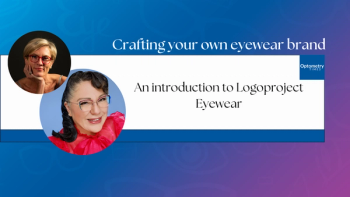
Lenses, frames and low vision: Vision care has come a long way
Once upon a time, and not so long ago, eyeglasses were made of-glass.
Once upon a time-and not so very long ago-eyeglasses were, well, glass.
Today, however, they are more likely to be polycarbonate or polyurethane, Trivex, CR-39, or plastic-and far thinner than they were 15 years ago. These lenses are likely to be doing double-duty-reducing refractive error while blocking specific colors of light, for example, or reducing glare while providing three-dimensional capabilities. And they will be framed in designer-approved shapes and colors, in metals or plastics, that offer myriad options to suit ever-changing tastes.
But even though the world of eyeglass options has sashayed as rapidly as the hips on a runway model, the public's understanding of low vision, and the eyecare industry's commitment to it, as a functional disability has evolved too-just much more slowly.
"Every time we think we're done [creating new features], something else comes out," said Al Berg, founder and chief executive officer of Marchon Eyewear.
Lenses
Some people might think lenses designed to ease driving glare and photochromic lenses are rather new inventions. But Jim Pritts, a lens innovator and now a sunglasses industry consultant, said he started developing these concepts more than 30 years ago.
"Sometimes, you're a little too far ahead of the market," he said.
Ten or 15 years ago, most sunglasses were being switched from glass to polycarbonate and acrylic lenses for their high-impact resistance. Since then, polyurethane replaced polycarbonate because of its superior optical properties, Pritts said. CR-39, a plastic polymer now belonging to PPG Industries, has become the dominant material in prescription lenses, he said, because it is relatively inexpensive to produce, wears well, is "reasonably" durable and reliable, and has good optics.
"There are some nylon lenses out there, but they never gained a big position in the market," he added.
In Pritts' mind, the biggest advancement in lenses has been the development of engineered tints, or engineered filtration, which allow wearers to block light that hinders specific activities. For example, skiers might choose yellow-tinted glasses to enhance contrast and depth perception.
"It used to be that sunglasses needed to be dark; they needed to block light," Pritts said. "But now people have learned that you can custom-design the filtration of the lens in specific ways that will improve your vision not just make you comfortable by blocking glare, and you can make them sport-specific."
Lens treatments also can be combined to be polarized-blocking road and windshield glare while driving, for example-and photochromic, darkening to the degree necessary. Such "bells and whistles" are being added in this difficult economy to avoid lowering prices, Pritts said.
Over the past few decades, Berg said, there have been some "dramatic" improvements in lenses. "There's no reason today you can't have comfortable lenses, not overly thick, not overly heavy," he said.
Pritts foresees the day when lenses are electronic-instantly darkening and adapting to changing light conditions-and prescription lenses have autofocus, like a camera, so the wearer can automatically focus on something important. "Eventually we'll have implants -bionic everything," he said.
Newsletter
Want more insights like this? Subscribe to Optometry Times and get clinical pearls and practice tips delivered straight to your inbox.















































.png)


